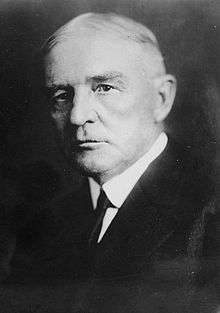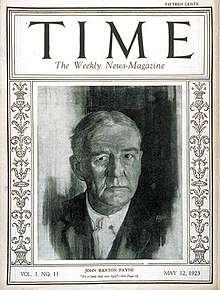John Barton Payne
John Barton Payne (January 26, 1855 – January 24, 1935) was an American politician, lawyer and judge. He served as the United States Secretary of the Interior from 1920 until 1921 under Woodrow Wilson's administration.
John Payne | |
|---|---|
 | |
| 27th United States Secretary of the Interior | |
| In office March 15, 1920 – March 4, 1921 | |
| President | Woodrow Wilson |
| Preceded by | Franklin Lane |
| Succeeded by | Albert B. Fall |
| Personal details | |
| Born | January 26, 1855 Pruntytown, West Virginia, U.S. |
| Died | January 24, 1935 (aged 79) Washington, D.C., U.S. |
| Resting place | Oak Hill Cemetery |
| Political party | Democratic |
| Spouse(s) | Kate Bunker Jennie Byrd Bryan |
Early life and career

Payne was born on January 26, 1855 in Pruntytown, West Virginia, the son of Amos Payne, who was a doctor and farmer, and the former Elizabeth Barton.[1]
Admitted to the bar in 1876 in West Virginia, Payne entered politics five years later as the chairman of the Preston County Democratic Party. He moved to Chicago, Illinois, in 1883, and was elected in 1893 to the Superior Court of Cook County, which he served on until resigning from that post in 1898.[2] After resigning his judgeship, Payne was the senior partner in Winston, Payne, Strawn and Shaw. A successor firm still exists. He was the president of the Chicago's South Park Board from 1911 to 1924.
After the outbreak of World War I, Payne went to Washington, D.C., to act as the counsel for the Emergency Fleet Corporation and was the national railroad administration. From 1919 through his appointment to Wilson's cabinet in February 1920, Payne served as the Chairman of the U.S. Shipping Board.
From October 1921 until his death, Payne served as the Chairman of the American Red Cross. In May 1921, Payne pledged funds for the permanent structure for the Warrenton Library[4] in Fauquier County, Virginia.
Payne was a founder of the Virginia Museum of Fine Arts in Richmond in 1911, and he donated 50 paintings to the museum in 1919.[5] Some of his personal papers were given to the Special Collections Research Center at the College of William & Mary.[6]
Personal life
Payne married Kate Bunker on October 17, 1878. She died after a long illness. Payne married his second wife, the former Jennie Byrd Bryan (daughter of the late Thomas Barbour Bryan), on May 1, 1913. Jennie Payne died in 1919, and he remained a widower in office.
He died of pneumonia after an operation for appendicitis on January 24, 1935, at the age of 79. Two days later, an Associated Press obituary ran in the Chicago Tribune. Payne was buried in Oak Hill Cemetery in Washington, D.C., next to his second wife.
In World War II, the United States liberty ship SS John Barton Payne was named in his honor.
Sources
- John B. Payne, Ex-Member of the Cabinet, Dead, Chicago Tribune, p. 1, Jan. 24, 1935
- American Red Cross website
- Fauquier County Public Library - Library History
References
- "Archived copy". Archived from the original on 2012-03-03. Retrieved 2009-12-23.CS1 maint: archived copy as title (link)
- "John B. Payne (1920–1921) | Miller Center". millercenter.org. 4 October 2016. Retrieved 11 May 2020.
- Donovan, Henry. "Chicago Eagle". Illinois Digital Newspaper Collections. Retrieved 29 June 2015.
- "Fauquier County Public Library -- Home Page". 20 August 2008. Retrieved 4 October 2018.
- "European Collection Fact Sheet - VMFA Press Room". vmfa.museum. Retrieved 4 October 2018.
- "John Barton Payne Papers". Special Collections Research Center, Earl Gregg Swem Library, College of William & Mary. Retrieved 4 February 2011.
External links
| Wikimedia Commons has media related to John Barton Payne. |
- American President.org - Secretary of the Interior: John B. Payne (1920 - 1921)
- Fauquier County Public Library - Library History
- International Red Cross and Red Crescent Movement History - John Barton Payne 1922-35
- Finding aid for the John Barton Payne Papers
| Political offices | ||
|---|---|---|
| Preceded by Franklin K. Lane |
U.S. Secretary of the Interior Served under: Woodrow Wilson March 15, 1920 – March 4, 1921 |
Succeeded by Albert B. Fall |
| Non-profit organization positions | ||
| Preceded by Henry Davison |
Chairman of the International League of Red Cross Societies 1922–1935 |
Succeeded by Cary Travers Grayson |
| Awards and achievements | ||
| Preceded by James M. Beck |
Cover of Time Magazine 12 May 1923 |
Succeeded by René Viviani |

